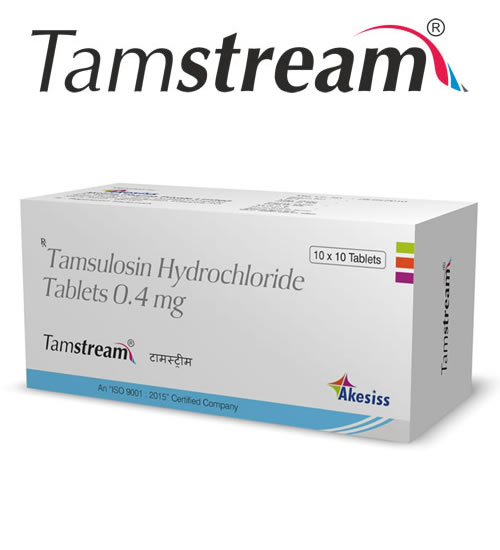COMPOSITION
Tamstream™
(Tamsulosin – 0.4 mg Tab)
Category: Alpha1A adrenoceptor antagonist
Mechanism of Action
Tamsulosin is a selective α1A adrenoreceptor-blocking agent. Smooth muscle tone is mediated by the sympathetic nervous stimulation of α1A adrenoreceptors, which are abundant in the prostate, prostatic capsule, prostatic urethra, and bladder neck. Blockade of these adrenoceptors can cause smooth muscles in the bladder neck and prostate to relax, resulting in an improvement in urine flow rate and reduction in symptoms in BPH.
Pharmacokinetics
Absorption:
Absorption is > 90% following oral administration of a 0.4-mg dose under fasting conditions. Bioavailability is increased by 30% and peak concentration is increased by 40 to 70% when Tamsulosin is taken in the fasting state compared to the nonfasting state.
Distribution:
Animal studies have found that tamsulosin is widely distributed to most tissues, including aorta, brown fat, gallbladder, heart, kidney, liver, and prostate; it is minimally distributed into the brain, spinal cord, and testes.
Protein binding:
Very high (94 to 99%) to plasma proteins, primarily to alpha-1 glycoprotein; binding is linear over a wide concentration range (20 to 600 nanograms per mL).
Biotransformation:
Tamsulosin is extensively metabolized by cytochrome P450 enzymes in the liver, with < 10% of the dose excreted in the urine unchanged. The metabolites undergo extensive conjugation to glucuronide or sulfate prior to renal excretion.
Elimination:
After administration of a radiolabeled dose of tamsulosin, 76% of the dose is recovered in the urine and 21% is recovered in the feces over 168 hours.
Indications
Tamsulosin is primarily used for benign prostatic hyperplasia, but can also assist the passage of kidney stones by the same mechanism of smooth muscle relaxation via alpha antagonism.
Adverse effects
Two adverse drug reactions have been reported:
Immunologic: It contains a sulfa moiety, thus causing typical reactions to sulfa drugs.
Ophthalmologic: Patients taking tamsulosin are prone to a complication known as floppy iris syndrome during cataract surgery.
Rarely resulting in dizziness or fainting. Other reported side effects include vertigo, headache, nasal congestion, and palpitations.
Contraindications
Cataract Surgery, Intraoperative Floppy Iris Syndrome, Continued Painful Erection, Feeling Faint, Dizzy, Hypersensitivity to sulfonamide, severe hepatic impairment, lactation.


